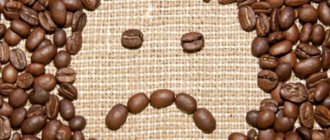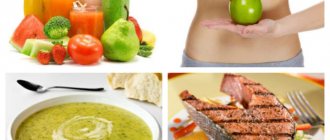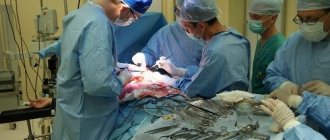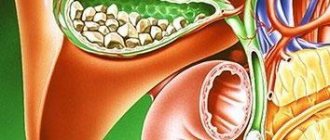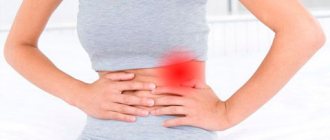Each person’s body is individual and differs in the nature and intensity of the metabolic processes occurring in it. For the smooth functioning of the body's systems, the stable functioning of each of its organs is necessary. One of these organs is the pancreas, diseases of which affect the functioning of not only the digestive, but also other systems. Sometimes a stone appears in the pancreas, then treatment must be started immediately.
Inflammation of the pancreas
Pancreatitis is inflammation of the pancreas and can be acute or chronic. Causes – poor diet, stones in the bile ducts, poisoning, smoking, chronic alcoholism, disruption of the gastrointestinal tract (stomach, duodenum), viral diseases, infections, etc. Symptoms of acute pancreatitis – nausea, vomiting, heartburn, aching, monotonous pain in abdomen, in the left hypochondrium, persisting for several days. As well as spasmodic pain in the lower abdomen, flatulence, abnormal bowel movements (diarrhea or constipation), chills or excessive sweating, an unpleasant taste in the mouth, and changes in skin color.
Stages of development of pacreolithiasis
Scientists and doctors distinguish 3 stages of development of pacreolithiasis:
- the first is characterized by an increase in the volume of pancreatic juice and its thickening, as a result of which, at the moment it enters the ducts, it begins to turn into insoluble protein compounds (there are no clinical manifestations of the disease);
- second - at this moment, calcium salts are deposited in the gland and an even greater thickening of pancreatic juice is observed (symptoms are also not observed);
- third – infection occurs and the main signs of disease development occur.
Treatment of pancreatic inflammation
Treatment of acute pancreatitis should take place in a hospital.
First aid - you need to apply an ice bag to the left hypochondrium, avoid eating any food. Drug treatment includes taking antispasmodics, painkillers (opioid analgesics), and antiemetics. In the acute phase, infusion drugs are administered intravenously. For complications, antibiotics may be prescribed. Fasting is observed for three to five days or parenteral nutrition is used.
Therapy for the chronic form of the disease is based on quitting smoking, drinking alcohol, diet therapy with a small amount of fat in the diet, using painkillers, taking enzyme preparations; antidepressants (pregabalin, gabapentin) can be prescribed to relieve pain, as well as treatment of complications.
If there are stones in the gland ducts, then it is rational to perform lithotripsy and endoscopic therapy.
Surgical treatment is performed when drug therapy is impossible or the body is tolerant to their action.
The duration of treatment depends on the form and complications of the disease, and on the body’s susceptibility to therapy.
Surgery to help patients with acute pancreatitis
After acute pancreatitis is confirmed in the victim, doctors first try to restore their former health without surgery. But when alternative approaches do not give the desired result, then radical measures cannot be avoided.
Experts note that, despite the seriousness of the disease, there are no strict criteria for indications for the procedure for acute pancreatitis.
The main indicators of the need to involve surgery are:
- infected pancreatic necrosis, which is characterized by purulent melting of tissue;
- ineffectiveness of conservative therapy for more than two days;
- abscesses;
- purulent accumulations in peritonitis.
The necrotic course of the disease, when suppuration haunts about 70% of all victims, is considered particularly difficult even for real professionals.
Without radical solutions, the mortality rate is 100%.
When infected pancreatic necrosis is confirmed in a patient, he is urgently prescribed an open laparotomy with cleansing of dead cells and drainage of the postoperative bed.
According to statistics, about 40% of clinical cases require repeat laparotomy in the future. Even an experienced gastroenterologist is unlikely to announce the exact time period. The reason for repetition is the need to completely get rid of harmful tissues affected by necrosis.
In particularly difficult scenarios, doctors do not even suture the abdominal cavity, leaving it open so that if there is a risk of bleeding, they can quickly pack the problem area.
Many people registered in the gastroenterology department of the hospital are interested in the fact of how much such care costs. But there is no specific figure here, since it takes into account the peculiarities of each operation along with the medications involved, anesthesia and subsequent recovery. Doctors warn that if a patient has undergone surgery, this is not the end of the expenses.
There is always a risk of needing re-intervention. The price will also increase due to the need to undergo quite a long rehabilitation. Separately, the cost is affected by the need to resort to cholecystectomy. This measure is necessary if, along with the main disease, the victim is also found to have gallstone disease. Then, in one go, the surgeon will get rid of the gallbladder.
Pancreatic tumors
A pancreatic tumor can be of two types – cancer and a hormonally active tumor.
Men are more often affected; the average age is 55 years. Most often the tumor is localized in the head of the gland. Factors that provoke the development of pancreatic cancer include smoking, chronic pancreatitis, high body mass index, and male gender.
Symptoms of cancer depend on the part of the gland that is affected. If the head of the gland is affected, jaundice may develop, because compression of the bile duct occurs. Skin itching appears. When the body and tail are affected, diabetes mellitus, varicose veins of the esophagus and stomach, and the risk of bleeding develop.
Treatment is surgical or chemotherapy.
Preoperative and postoperative periods
Preparing for pancreatic surgery is not much different from preparing for other operations. The peculiarity is that operations on the pancreas are performed mainly for health reasons, that is, only in cases where the risk of non-intervention far exceeds the risk of the operation itself. Therefore, only a very serious condition of the patient is a contraindication for such operations. Surgeries on the pancreas are performed only under general anesthesia.
After surgery on the pancreas, the first few days are carried out with parenteral nutrition (nutrient solutions are introduced through a dropper into the blood) or during the operation an intestinal tube is installed and special nutritional mixtures are introduced through it directly into the intestines.
After three days, you can first drink, then pureed semi-liquid food without salt and sugar.
Complications after pancreatic surgery
- Purulent inflammatory complications - pancreatitis, peritonitis, abscesses, sepsis.
- Bleeding.
- Anastomotic failure.
- Diabetes.
- Disorders of digestion and absorption of food - malabsorption syndrome.
Pancreatic stones
Pancreolithiasis is the formation of stones in the pancreatic ducts.
Often stones form if there is a cyst or tumor; this is one of the complications of chronic pancreatitis. Stagnant processes occur in the organ, the secretion of the pancreas thickens, and the protein precipitates. The ducts dilate, the pressure in them increases, and symptoms of pancreatitis appear. Symptoms of pancreolithiasis:
- burning pain in the abdomen radiating to the back and shoulder blade;
- nausea, vomiting with bile;
- steatorrhea – “fatty” stool;
- diabetes;
- increased salivation;
- obstructive jaundice.
Diagnosis of pancreatic diseases
To diagnose diseases of the pancreas, the doctor examines and palpates the abdomen and prescribes laboratory and instrumental methods.
A biochemical blood test examines the level of pancreatic enzymes (amylase, lipase), blood glucose, and liver function tests.
A stool analysis is carried out to assess the deficiency of enzyme production, the presence of undigested food, fat, and certain enzymes (pancreatic elastase) is examined.
Visual instrumental examinations are carried out using transabdominal ultrasound (ultrasound of the abdominal cavity), CT, radiography, magnetic resonance cholangiopancreatography.
Diet for diseases of the pancreas
The diet should include soft, well-chopped food.
Steam, bake, boil, stew foods. Include puree soups and cream soup in your diet. Bread can be consumed dried, yesterday's bread made from first and second grade flour. Meat - chicken, turkey, lean parts of beef, low-fat fish is allowed. Eggs should be in the form of omelettes, steamed in the oven. You can eat non-acidic types of fruits, baked fruits. You can drink rosehip decoction, sugar-free compote, herbal teas, water. Of the fats in the diet, butter with 82.5% fat content and sunflower oil should be present, but limited. Food should be taken warm. It is necessary to exclude sausages, smoked meats, fatty, fried, canned and pickled foods.
Forbidden:
- alcohol;
- spicy food;
- coffee;
- energy, carbonated sweet drinks;
- chocolate;
- ice cream;
- duck, goose meat, pork, lard, bacon;
- legume products;
- garlic, cabbage;
- grapes, bananas.
The severity of the diet depends on the disease of the pancreas. In the acute period, fasting is prescribed for three to five days; in case of exhaustion, parenteral and special enteral nutrition is used.
Fully or partially limited products
The diet of patients with this disease should not contain:
- Broths (meat/mushroom/fish), do not eat borscht, cabbage soup, okroshka and beetroot soup.
- Vegetables with coarse fiber, which include: rutabaga, cabbage, radishes, turnips, radishes, eggplants, legumes and mushrooms.
- Offal, fatty fish and meat, any fried foods, including fried eggs, smoked meats, stewed meat or fish, sausages, canned food, fish roe, dried salted fish.
- Rye bread, any fresh pastries, confectionery (pastries, cakes, cookies) with cream, fried flour products (pies, pancakes, pancakes, cheesecakes).
- Dry, crumbly and uncooked porridge. Excluded from the diet are: millet, barley, pearl barley and corn porridge, which are considered coarse and difficult to digest.
- Raw vegetables and fruits, which after an exacerbation are administered very carefully, observing how you feel.
- Black strong coffee, grape juice, chocolate, ice cream, jam, honey, cocoa, any carbonated drinks.
- Alcohol.
- Cooking fats, cream, lard, full-fat milk and cottage cheese; high-acid cottage cheese is also not suitable for consumption.
- Seasonings, sauces and spices (horseradish, ketchup, mustard, pepper, mayonnaise).
- Excessively sweet fruits with a high carbohydrate content - bananas, grapes, dates, which can increase bloating.
Table of prohibited products
| Proteins, g | Fats, g | Carbohydrates, g | Calories, kcal | |
Vegetables and greens | ||||
| canned vegetables | 1,5 | 0,2 | 5,5 | 30 |
| eggplant | 1,2 | 0,1 | 4,5 | 24 |
| swede | 1,2 | 0,1 | 7,7 | 37 |
| peas | 6,0 | 0,0 | 9,0 | 60 |
| cabbage | 1,8 | 0,1 | 4,7 | 27 |
| bulb onions | 1,4 | 0,0 | 10,4 | 41 |
| chickpeas | 19,0 | 6,0 | 61,0 | 364 |
| salad pepper | 1,3 | 0,0 | 5,3 | 27 |
| parsley | 3,7 | 0,4 | 7,6 | 47 |
| radish | 1,2 | 0,1 | 3,4 | 19 |
| white radish | 1,4 | 0,0 | 4,1 | 21 |
| dill | 2,5 | 0,5 | 6,3 | 38 |
| beans | 7,8 | 0,5 | 21,5 | 123 |
| horseradish | 3,2 | 0,4 | 10,5 | 56 |
| spinach | 2,9 | 0,3 | 2,0 | 22 |
| sorrel | 1,5 | 0,3 | 2,9 | 19 |
Fruits | ||||
| bananas | 1,5 | 0,2 | 21,8 | 95 |
Berries | ||||
| grape | 0,6 | 0,2 | 16,8 | 65 |
Mushrooms | ||||
| mushrooms | 3,5 | 2,0 | 2,5 | 30 |
| marinated mushrooms | 2,2 | 0,4 | 0,0 | 20 |
Nuts and dried fruits | ||||
| nuts | 15,0 | 40,0 | 20,0 | 500 |
| raisin | 2,9 | 0,6 | 66,0 | 264 |
| seeds | 22,6 | 49,4 | 4,1 | 567 |
| dates | 2,5 | 0,5 | 69,2 | 274 |
Cereals and porridges | ||||
| corn grits | 8,3 | 1,2 | 75,0 | 337 |
| millet cereal | 11,5 | 3,3 | 69,3 | 348 |
| barley grits | 10,4 | 1,3 | 66,3 | 324 |
Flour and pasta | ||||
| pasta | 10,4 | 1,1 | 69,7 | 337 |
| dumplings | 11,9 | 12,4 | 29,0 | 275 |
Bakery products | ||||
| buns | 7,9 | 9,4 | 55,5 | 339 |
| Rye bread | 6,6 | 1,2 | 34,2 | 165 |
Confectionery | ||||
| pastry cream | 0,2 | 26,0 | 16,5 | 300 |
| shortbread dough | 6,5 | 21,6 | 49,9 | 403 |
Ice cream | ||||
| ice cream | 3,7 | 6,9 | 22,1 | 189 |
Chocolate | ||||
| chocolate | 5,4 | 35,3 | 56,5 | 544 |
Raw materials and seasonings | ||||
| mustard | 5,7 | 6,4 | 22,0 | 162 |
| mayonnaise | 2,4 | 67,0 | 3,9 | 627 |
Dairy | ||||
| milk 4.5% | 3,1 | 4,5 | 4,7 | 72 |
| cream 35% (fat) | 2,5 | 35,0 | 3,0 | 337 |
| whipped cream | 3,2 | 22,2 | 12,5 | 257 |
| sour cream 30% | 2,4 | 30,0 | 3,1 | 294 |
Cheeses and cottage cheese | ||||
| parmesan cheese | 33,0 | 28,0 | 0,0 | 392 |
Meat products | ||||
| fatty pork | 11,4 | 49,3 | 0,0 | 489 |
| salo | 2,4 | 89,0 | 0,0 | 797 |
| bacon | 23,0 | 45,0 | 0,0 | 500 |
Sausages | ||||
| smoked sausage | 9,9 | 63,2 | 0,3 | 608 |
Bird | ||||
| smoked chicken | 27,5 | 8,2 | 0,0 | 184 |
| duck | 16,5 | 61,2 | 0,0 | 346 |
| smoked duck | 19,0 | 28,4 | 0,0 | 337 |
| goose | 16,1 | 33,3 | 0,0 | 364 |
Fish and seafood | ||||
| smoked fish | 26,8 | 9,9 | 0,0 | 196 |
| black caviar | 28,0 | 9,7 | 0,0 | 203 |
| salmon caviar granular | 32,0 | 15,0 | 0,0 | 263 |
| salmon | 19,8 | 6,3 | 0,0 | 142 |
| canned fish | 17,5 | 2,0 | 0,0 | 88 |
| salmon | 21,6 | 6,0 | — | 140 |
| trout | 19,2 | 2,1 | — | 97 |
Oils and fats | ||||
| animal fat | 0,0 | 99,7 | 0,0 | 897 |
| cooking fat | 0,0 | 99,7 | 0,0 | 897 |
Alcoholic drinks | ||||
| dry red wine | 0,2 | 0,0 | 0,3 | 68 |
| vodka | 0,0 | 0,0 | 0,1 | 235 |
| beer | 0,3 | 0,0 | 4,6 | 42 |
Non-alcoholic drinks | ||||
| soda water | 0,0 | 0,0 | 0,0 | — |
| cola | 0,0 | 0,0 | 10,4 | 42 |
| instant coffee dry | 15,0 | 3,5 | 0,0 | 94 |
| sprite | 0,1 | 0,0 | 7,0 | 29 |
Juices and compotes | ||||
| grape juice | 0,3 | 0,0 | 14,0 | 54 |
| * data is per 100 g of product | ||||
